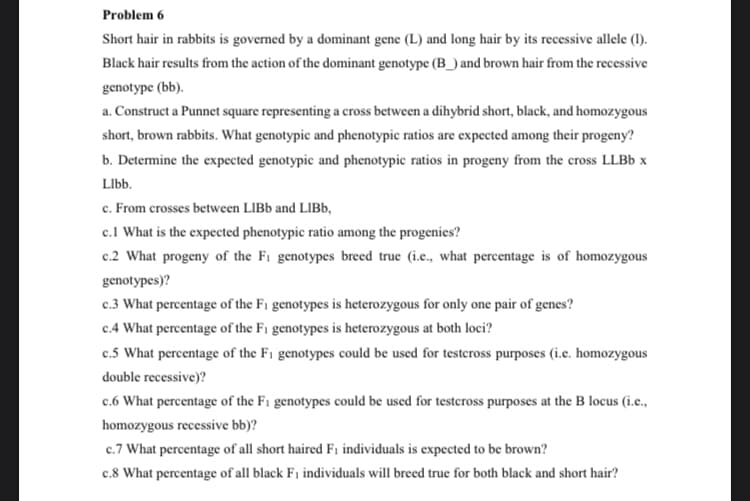Short hair in rabbits is governed by a dominant gene (L) and long hair by its recessive allele (1). Black hair results from the action of the dominant genotype (B_) and brown hair from the recessive genotype (bb). a. Construct a Punnet square representing a cross between a dihybrid short, black, and homozygous short, brown rabbits. What genotypic and phenotypic ratios are expected among their progeny? b. Determine the expected genotypic and phenotypic ratios in progeny from the cross LLBB x Llbb. c. From crosses between LIBB and LIBb, c.1 What is the expected phenotypic ratio among the progenies?
Short hair in rabbits is governed by a dominant gene (L) and long hair by its recessive allele (1). Black hair results from the action of the dominant genotype (B_) and brown hair from the recessive genotype (bb). a. Construct a Punnet square representing a cross between a dihybrid short, black, and homozygous short, brown rabbits. What genotypic and phenotypic ratios are expected among their progeny? b. Determine the expected genotypic and phenotypic ratios in progeny from the cross LLBB x Llbb. c. From crosses between LIBB and LIBb, c.1 What is the expected phenotypic ratio among the progenies?
Chapter1: Numerals And Fractions
Section: Chapter Questions
Problem 5PP
Related questions
Topic Video
Question

Transcribed Image Text:Problem 6
Short hair in rabbits is governed by a dominant gene (L) and long hair by its recessive allele (I).
Black hair results from the action of the dominant genotype (B_) and brown hair from the recessive
genotype (bb).
a. Construct a Punnet square representing a cross between a dihybrid short, black, and homozygous
short, brown rabbits. What genotypic and phenotypic ratios are expected among their progeny?
b. Determine the expected genotypic and phenotypic ratios in progeny from the cross LLBB x
Llbb.
c. From crosses between LIBB and LIBB,
c.1 What is the expected phenotypic ratio among the progenies?
с.
c.2 What progeny of the Fi genotypes breed true (i.e., what percentage is of homozygous
genotypes)?
c.3 What percentage of the F1 genotypes is heterozygous for only one pair of genes?
c.4 What percentage of the F1 genotypes is heterozygous at both loci?
c.5 What percentage of the F1 genotypes could be used for testeross purposes (i.c. homozygous
double recessive)?
c.6 What percentage of the F1 genotypes could be used for testeross purposes at the B locus (i.e.,
homozygous recessive bb)?
c.7 What percentage of all short haired Fi individuals is expected to be brown?
c.8 What percentage of all black F1 individuals will breed true for both black and short hair?
Expert Solution
This question has been solved!
Explore an expertly crafted, step-by-step solution for a thorough understanding of key concepts.
This is a popular solution!
Trending now
This is a popular solution!
Step by step
Solved in 5 steps with 3 images

Knowledge Booster
Learn more about
Need a deep-dive on the concept behind this application? Look no further. Learn more about this topic, biology and related others by exploring similar questions and additional content below.Recommended textbooks for you

